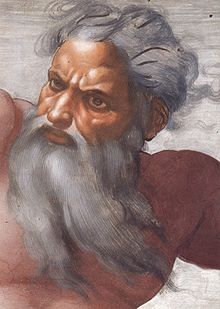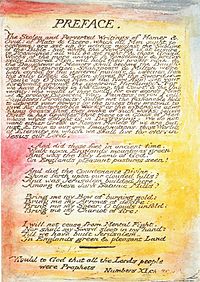- Divine countenance
-
The divine countenance is the face of God.
Contents
Religion
Pagan
In pagan religions, the face of God might be viewed in a literal sense - the face of an idol in a temple.[1] In prayers and blessings, the concept was more metaphorical, indicating the favourable attention of the deity. For example, in the Babylonian blessing:[2]
"May Ea rejoice over thee!
May Damkina, the queen of the deep, lighten thee with her countenance!
May Marduk, the great overseer of the Igigi, lift up thy head!"Jewish and Christian
 Andrea Mantegna, Sacrifice of Isaac The Hand of God was the only part of God shown in art for many centuries.
Andrea Mantegna, Sacrifice of Isaac The Hand of God was the only part of God shown in art for many centuries.
In the Book of Exodus 33:20 God says "Thou canst not see my face: for there shall no man see Me and live", echoed in the Christian New Testament in the Gospel of John 1:18: "No man hath seen God at any time".
In Judeo-Christianity, the concept is the manifestation of God rather than a remote immanence or delegation of an angel, even though a mortal would not be able to gaze directly upon him.[3] In Jewish mysticism, it is traditionally believed that even the angels who attend him cannot endure seeing the divine countenance directly.[4] Where there are references to visionary encounters, these are thought to be either products of the human imagination, as in dreams or, alternatively, a sight of the divine glory which surrounds God, not the godhead itself.[5]
An important early use of the concept in the Old Testament is the blessing passed by Moses to the children of Israel in Numbers 6:24–26[6]
"The LORD bless thee, and keep thee:
The LORD make his face shine upon thee, and be gracious unto thee:
The LORD lift up his countenance upon thee, and give thee peace."[7]The name of the city of Peniel literally means the "face of God" in Hebrew. The place was named by Jacob after his wrestling match there which is recounted in Genesis. His opponent seemed divine and so Jacob claimed to have looked upon the face of God.[8]
Islam
Islam considers Allah to be beyond ordinary vision as the Qu'ran states that "Sights cannot attain him; he can attain sights",[9] but other verses indicate that he would be visible in the hereafter.[10] The Qu'ran makes many references to the face of God but its use of the Arabic word for a physical face — wajh — is symbolic and is used in the tradition of Judeo-Christianity to refer to God's presence which, in Islam, is everywhere: "wherever you turn, there is the face of God".[11]
God is visible but not with physical eyes but with inner eyes which the Quran states
006.104 YUSUFALI: "Now have come to you, from your Lord, proofs (to open your eyes hidden eyes): if any will see, it will be for (the good of) his own soul; if any will be blind, it will be to his own (harm): I am not (here) to watch over your doings."
In the arts
God was represented by the Hand of God, in fact including the forearm but no more of the body, at several places in the 3rd century Dura-Europos synagogue, presumably reflecting the usual practice in ancient Jewish art, almost all of which is now lost. The Hand convention was continued in Christian art, which also used full body depictions of the God the Son with the appearance of Jesus for Old Testament scenes, in particular the story of Adam and Eve, where God needed to be represented.[12] The biblical statements from Exodus and John quoted above were taken to apply not only to God the Father in person, but to all attempts at the depiction of his face.[13] The development of full images of God the Father in Western art was much later, and the aged white-haired appearance of the Ancient of Days gradually became the conventional representation, after a period of experimentation, especially in images the Trinity, where all three persons might be shown with the appearance of Jesus. In Eastern Orthodoxy the depiction of God the Father remains unusual, and has been forbidden at various church councils; many early Protestants did the same, and in the Counter Reformation the Catholic Church discouraged the earlier variety of depictions but explicitly supported the Ancient of Days.
The description of the Ancient of Days, identified with God by most commentators,[14] in the Book of Daniel is the nearest approach to a physical description of God in the Hebrew Bible:[15]
. ...the Ancient of Days did sit, whose garment was white as snow, and the hair of his head like the pure wool: his throne was like the fiery flame, and his wheels as burning fire. (Daniel 7:9)
The "countenance divine" appears in the lines of the famous poem, And did those feet in ancient time, by William Blake which first appeared in the preface to his epic Milton a Poem. Blake thought highly of Milton's work saying, "I have the happiness of seeing the Divine countenance in ... Milton more distinctly than in any prince or hero."[16]
See also
References
- ^ Walther Eichrodt (1967), "Spiritualization of the theophany", Theology of the Old Testament, 2, http://books.google.com/books?id=fom-0E7QjMMC&pg=PA35, "The panim (the face) of God"
- ^ Alfred Jeremias (1930), Das alte Testament im Lichte des Alten Orients
- ^ Gustav Friedrich Oehler (1870), "The Divine Countenance and the Divine Glory", Theology of the Old Testament, http://books.google.com/books?id=T5OUVTQYPr4C&pg=185
- ^ Schäfer, Peter (1992). The hidden and manifest God: some major themes in early Jewish mysticism. SUNY Press. p. 17. ISBN 9780791410448. http://books.google.ca/books?id=4u-qdHyoPggC&printsec=frontcover#v=onepage&q&f=false.
- ^ Geoffrey W. Dennis (2007), "Face (or Countenance) of God", The encyclopedia of Jewish myth, magic and mysticism, http://books.google.com/books?id=Ojl_wsv0x3QC&pg=91
- ^ F. LeRon Shults (2005), Reforming the doctrine of God, http://books.google.co.uk/books?id=96adcPdRZ8IC&pg=PA274, "The ontological significance of the face of God is a theme that may be traced through every genre of the Hebrew Bible."
- ^ Book of Numbers 6:24-26, Authorized King James Version of the Bible. London: Robert Barker, King's Printer. 1611.
- ^ Richard R. Losch, "Peniel", The uttermost part of the earth: a guide to places in the Bible, http://books.google.co.uk/books?id=JNaeQmqthWsC&pg=PA155
- ^ Tim Winter, T. J. Winter (2008), "God:essence and attributes", The Cambridge companion to classical Islamic theology, http://books.google.co.uk/books?id=J5QKXdAMHvcC&pg=PA127
- ^ Francis E. Peters (1990), "The Vision of God", Judaism, Christianity, and Islam: the classical texts and their interpretation, http://books.google.co.uk/books?id=yoV5f3U2PPoC&pg=PA395
- ^ Andrew Rippin (2000), ""Desiring the Face of God": The Qu'ranic Symbolism of Personal Responsibility", Literary structures of religious meaning in the Qur'ān, http://books.google.co.uk/books?id=SdgaD-7C6TkC&pg=PA120
- ^ Adolphe Napoléon Didron, 2003 Christian iconography: or The history of Christian art in the middle ages, Volume 1 ISBN 076614075X pages 167-170
- ^ James Cornwell, 2009 Saints, Signs, and Symbols: The Symbolic Language of Christian Art ISBN 081922345X page 2
- ^ God the Father by Western Christians; after centuries of debate, the Russian Orthodox Church decided in 1667 that the Ancient of Days was God the Son
- ^ Bigham Chapter 7
- ^ Joseph Anthony Wittreich, Jr. (Feb. 1975)), ""Divine Countenance": Blake's Portrait and Portrayals of Milton", Huntington Library Quarterly 38 (2): 125–160, JSTOR 3816778
Categories:- Conceptions of God
- Allah
- Judeo-Christian topics
- Christian iconography
Wikimedia Foundation. 2010.


